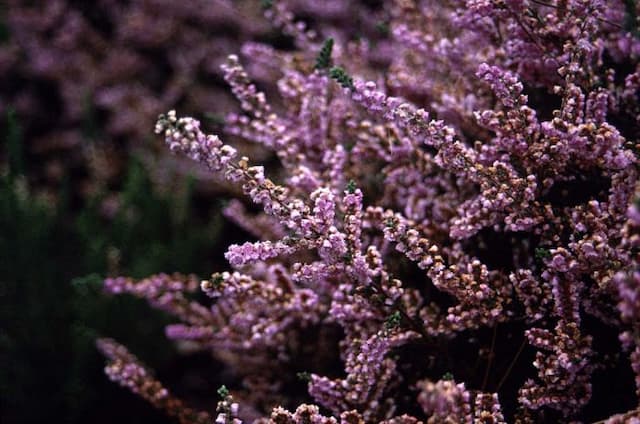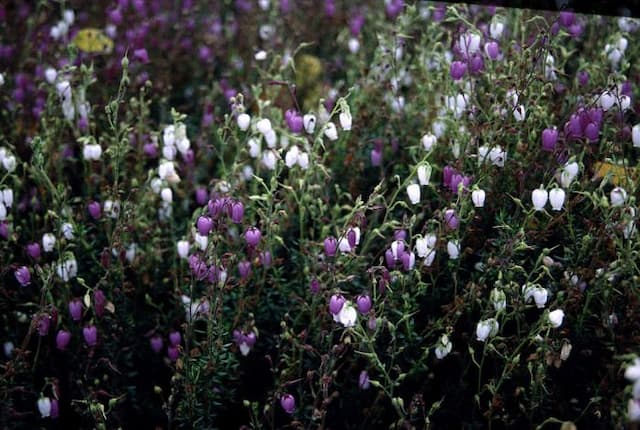Bilberry Vaccinium myrtillus

ABOUT
The plant known as bilberry is a small, perennial shrub that bears distinctive features. It has small, round, green leaves that take on a slightly oval shape with toothed edges that can give them a somewhat jagged appearance. The leaves are quite delicate and have a smooth texture. During its flowering season, the bilberry produces bell-shaped flowers that are small and typically range in color from pink to white. These flowers are subtle and sometimes may go unnoticed as they nestle amidst the greenery of the plant. The real standout feature of the bilberry plant is its fruit. The berries are small, round, and have a dark blue to purple-black color when ripe. They have a glossy appearance and are dotted with tiny pocks or seeds on their surface. The berries cluster together on the plant and are a favorite among birds and other wildlife due to their juicy and flavorful nature. Overall, the bilberry plant has a bushy, dense growth habit, lending it a look of lushness even when it's not bearing fruit. The combination of its delicate flowers, vibrant green leaves, and the richly colored berries make it a plant that is as attractive as it is useful.
About this plant
 Names
NamesFamily
Ericaceae.
Synonyms
European Blueberry, Bilberry, Whortleberry, Huckleberry, European Huckleberry, Blaeberry, Myrtle Blueberry, Fraughan, Airelle.
Common names
Vaccinium myrtillus var. myrtillus, Vaccinium myrtillus var. oreophilum, Myrtillus niger Gilib., Vaccinium montanum Salisb., Vaccinium myrtillus var. microphyllum Lange, Vaccinium myrtillus f. microphyllum (Lange) Tolm., Vaccinium myrtillus f. oreophilum (Rydb.) Tolm., Vaccinium myrtillus var. oreophilum Rydb., Vaccinium myrtillus f. albocarpum Tolm.
 Toxicity
ToxicityTo humans
The plant known as bilberry, while popular for its edible berries, is not considered toxic to humans when consumed in typical food quantities. Consuming bilberry parts other than the fruit is not commonly reported, and there is no significant evidence to suggest toxicity to humans from the non-fruit parts of the plant. However, as with any plant, individual allergies may exist, and excessive consumption of the berries could possibly lead to mild gastrointestinal upset due to fiber content.
To pets
Bilberry is not typically known to be toxic to pets. The berries themselves are often considered safe for pets to eat in moderation. However, it is generally advisable to exercise caution and limit the ingestion of non-familiar foods by pets to prevent potential stomach upset or an allergic reaction, although no specific toxicity has been frequently reported with Vaccinium myrtillus in pets.
 Characteristics
CharacteristicsLife cycle
Perennials
Foliage type
Deciduous
Color of leaves
Green
Flower color
Pinkish-white
Height
1-2 feet (30-60 cm)
Spread
1-2 feet (30-60 cm)
Plant type
Shrub
Hardiness zones
3-7
Native area
Europe
Benefits
 General Benefits
General Benefits- Rich in Antioxidants - Vaccinium myrtillus (European blueberry) is high in compounds such as anthocyanins, which help to protect cells from oxidative stress.
- Nutritional Value - The berries are a good source of vitamins C and K, fiber, and manganese, providing essential nutrients to the diet.
- Low-Calorie Snack - European blueberries are low in calories, making them a healthy snack option for weight management.
- Supports Vision - The berries contain compounds that are traditionally believed to support eye health and improve vision.
- Wildlife Habitat - The plant provides food and habitat for various species of birds and other wildlife.
- Landscape Use - Vaccinium myrtillus can be used in gardens and landscaping for aesthetic purposes due to its attractive flowers and berries.
- Cultural Significance - European blueberries have a long history of use in local cuisines and traditional practices in various cultures.
 Medical Properties
Medical Properties- Antioxidant activity: Vaccinium myrtillus, commonly known as bilberry, has been shown to contain high levels of antioxidants, which may help protect cells from damage.
- Eye health support: Bilberry is traditionally associated with improving night vision and has been used to help with various eye conditions, thanks to the presence of anthocyanins.
- Anti-inflammatory properties: The compounds found in bilberry may help in reducing inflammation in the body.
- Blood sugar regulation: There is some evidence to suggest that bilberry may aid in blood sugar regulation, which is beneficial for individuals with diabetes or at risk of diabetes.
- Vascular support: Bilberry may strengthen blood vessels and improve circulation, potentially helping with conditions like varicose veins and venous insufficiency.
- Diarrhea and gastrointestinal relief: Bilberry fruit has been used traditionally to help with diarrhea and other gastrointestinal issues due to its tannin content.
- Antimicrobial effects: Some research indicates that bilberry possesses antimicrobial properties that could be beneficial in fighting certain bacterial infections.
 Air-purifying Qualities
Air-purifying QualitiesThis plant is not specifically known for air purifying qualities.
 Other Uses
Other Uses- Vaccinium myrtillus, also commonly known as bilberry, can be used as a natural fabric dye. The berries produce shades of blue and purple, depending on the mordant used.
- Bilberry plants can serve as a food source for wildlife; birds and mammals eat the berries.
- Bilberry leaves have been traditionally used for tea, offering a mild flavor.
- The bilberry fruit can be used in the production of natural food coloring for bakery products and confectioneries due to its deep blue/purple hue.
- Bilberry bushes can act as erosion control on steep or unstable slopes due to their root system.
- The bilberry plant is an ornamental addition to naturalistic gardens, adding color and texture to the landscape.
- Bilberry can be used in culinary applications beyond dessert; the berries contribute acidity and color to meat sauces and chutneys.
- Fermented bilberries are used in some countries to produce fruit wines or liqueurs with a unique flavor profile.
- The bilberry is a symbol in some cultures and is used in decorations and motifs celebrating local heritage and folklore.
- Dried bilberry leaves can be a component in potpourri mixes, contributing to the visual appeal and fragrance.
Interesting Facts
 Feng Shui
Feng ShuiBilberry is not used in Feng Shui practice.
 Zodiac Sign Compitability
Zodiac Sign CompitabilityBilberry is not used in astrology practice.
 Plant Symbolism
Plant Symbolism- Protection: Vaccinium myrtillus, commonly known as Bilberry, has been associated with protective qualities, believed to ward off negative energies and spirits when carried or placed in a home.
- Good Health: Due to Bilberry's rich antioxidant content and health benefits, it symbolizes good health and well-being.
- Abundance: The Bilberry plant, known for its plentiful berries, can represent abundance and gratitude for the nurturance of nature.
- Wisdom: In some cultures, Bilberry is linked to wisdom and foresight, perhaps due to its connection with improved vision, both literally and metaphorically.
- Humility: The Bilberry is a small fruit that grows in modest, wild environments, often symbolizing humility and unassuming strength.
 Water
WaterBilberry plants, commonly known as Vaccinium myrtillus, require consistent moisture, especially during their growing season, but they do not tolerate waterlogged conditions. They should be watered deeply once a week with approximately 1 to 1.5 gallons of water, depending on soil drainage and weather conditions. In periods of drought or extreme heat, watering frequency should be increased to ensure the soil remains moist but not soggy. During the winter dormant period, reduce watering to prevent root rot but do not let the soil dry out completely.
 Light
LightBilberries, or Vaccinium myrtillus, thrive in partial to full sun exposure, preferring bright, indirect light or filtered sunlight. The ideal spot for bilberry plants is where they receive morning sunlight and afternoon shade, which helps to protect them from intense midday heat. Avoid deep shade as it can reduce fruit production and lead to weak growth.
 Temperature
TemperatureBilberries, also known as Vaccinium myrtillus, prefer cooler climates and are hardy in a range of temperatures. They can tolerate a minimum temperature of around 20°F but the plants may suffer damage below this point. The ideal temperature range for growing bilberries is between 60°F and 70°F. They can withstand up to 85°F, but prolonged exposure to higher temperatures may impact fruit production and plant health.
 Pruning
PruningPruning bilberry plants, known as Vaccinium myrtillus, helps to maintain plant health, encourage new growth, and can boost fruit production. Prune the plants in late winter or early spring before new growth begins by removing dead or damaged branches and thinning out overcrowded areas to improve air circulation. Annually prune about a third of the oldest stems to ground level to rejuvenate the plant.
 Cleaning
CleaningAs needed
 Soil
SoilBilberry plants thrive in acidic soil with a pH of around 4.5 to 5.5. To create the best soil mix for bilberries, combine peat moss, pine bark, and sandy loam in equal parts. This replicates the plant's natural woodland floor habitat and ensures good drainage while retaining adequate moisture. Regularly testing the soil pH and amending with sulfur can help maintain the desired acidity.
 Repotting
RepottingBilberries, or European blueberries, typically do not need frequent repotting as they are slow-growing. Repotting every 2-3 years is usually sufficient. It's best to repot in the spring before the growing season begins, ensuring minimal disruption to the plant's growth cycle.
 Humidity & Misting
Humidity & MistingBilberry plants prefer moderate humidity levels and can adapt to the humidity found in most temperate environments. In areas with very dry air, maintaining humidity around the plant may be beneficial, but there is no specific humidity level required for bilberry plants to thrive.
 Suitable locations
Suitable locationsIndoor
Provide acidic soil, partial shade, and cool temps for bilberries.
Outdoor
Plant bilberries in acidic soil, partial shade, and cooler spots.
Hardiness zone
2-6 USDA
 Life cycle
Life cycleVaccinium myrtillus, also known as bilberry, begins its life cycle as a seed, which germinates under appropriate conditions of moisture and temperature, developing into a seedling. The seedling grows and establishes a root system, eventually developing into a mature bush that can reach up to 40 cm in height. Bilberry plants are perennial and enter a yearly cycle of growing new shoots and leaves in the spring. During late spring to early summer, bilberry bushes produce bell-shaped flowers, which, upon pollination by insects, develop into small, round, edible blue-black berries by mid-summer. The plant relies on animals and birds to disperse its seeds when the fruits are eaten, ensuring the continuation of the plant's life cycle. In autumn, the leaves turn red and fall off as the plant enters dormancy for the winter, rejuvenating the next spring to repeat the cycle.
 Propogation
PropogationPropogation time
Spring to summer
The most popular method of propagation for Vaccinium myrtillus, commonly known as bilberry, is through softwood cuttings. This is typically conducted in early to mid-summer when the new growth is still flexible. Cuttings about 4 to 6 inches (10 to 15 cm) long are taken from healthy shoots with at least two to three sets of leaves. The lower leaves are removed, and the cut end of the cutting is dipped in rooting hormone to encourage root development. The prepared cuttings are then placed in a moist propagation medium such as a mix of peat and perlite, ensuring at least one set of leaves remains above the surface. The environment should be kept humid, and cuttings are usually ready to be transplanted after they have rooted, which typically takes several weeks.









